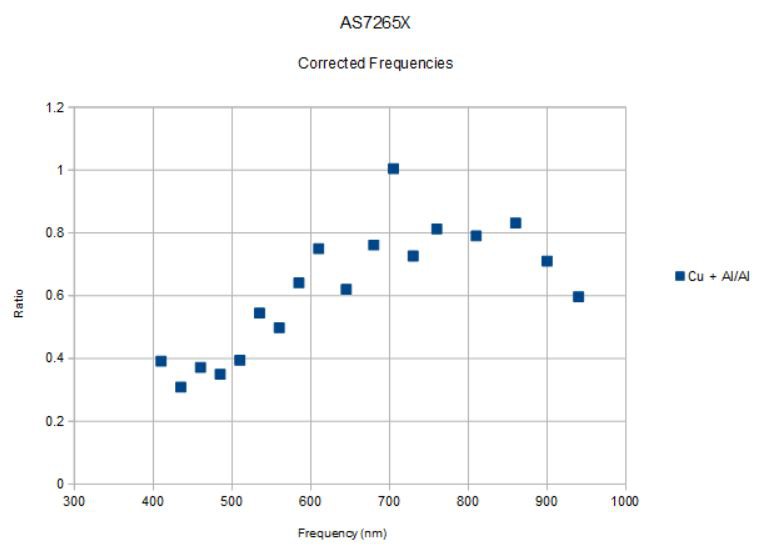09/26/2018
First some housekeeping. I have a supply of these Compact AS7265X Spectrometers for sale now at Tindie and I expect to keep these in stock as long as there is demand. Thanks to all for the support!
While tidying up the Tindie description I noticed that the data sheet link was 404 and when I found the most current datasheet dated July 9, 2018 I discovered that the order of the data in the registers was given differently from what I had believed. That is, the preliminary datasheet I received from AMS in excel spreadsheet format had some of the frequencies transposed and/or swapped. This is all part of rolling out a new sensor suite and it is quite possible I simply misinterpreted the spreadsheet and got it wrong. The error amounts to the following:
The previous version of data slots 1 - 18:
uint16_t freq[18] = {610, 680, 730, 760, 810, 860, 705, 645, 560, 585, 900, 940, 485, 460, 410, 435, 510, 535};
The new version of data slots 1 - 18:
uint16_t freq[18] = {610, 680, 730, 760, 810, 860, 560, 585, 645, 705, 900, 940, 410, 435, 460, 485, 510, 535};
Quite a bit different, eight (in bold) of eighteen channels were assigned the wrong frequency! This helps explain some of the mysterious results I was getting before, where the spectrometer seemed to be having trouble detecting a simple copper edge.
So, let's try that again with the correct(ed) frequency bins.
Here are the spectra from aluminum foil and with the same 0.999 copper coin on top of the aluminum foil under the spectrometer and both illuminated with the 5700 K CRI 90 white led at 50 mA, at 16 x gain, and at 100 ms integration time. The spectra were averaged over about 30 seconds and then captured to a spreadsheet. The spectrometer was held by a "third-hand" pointed down with the targets on the table under the spectrometer. I made an effort not to disturb the device geometry between the two runs, but otherwise I took no great pains in order to simulate what one might expect from more or less casual use.
This is what I measured:

You can see that there is a fair amount of variation from channel to channel (for example, 585 nm to 610 nm). I don't think this is all due to the variation in the reflected light but rather due also to the variation of the sensitivity of the individual channels. This means the spectra measured are really only meaningful when compared to a reference. In this case, aluminum (even aluminum foil) is a pretty good reflector so makes an adequate standard for this demonstration. But teflon is supposed to be even better for reflectometry since it reflects the same at nearly all visible wavelengths.
Taking the ratio of the Cu + Al spectrum to the Al spectrum I get the following:

Compare to what we should expect:

and it looks recognizable now. There is low reflectivity below the edge (400 - 500 nm), a 2x rise over ~100 nm that represents the absorption edge, and a more or less constant or gently rising plateau above the edge. There is still a bit of jitter, likely meaning we need to average the spectra further and/or increase the led current from 50 mA to maybe 100 mA, etc. But the results are no longer unintelligible.
The spectrometer is behaving now as I expect it should and it is time to revisit some of the older experiments to see if we can distinguish silver, gold, and copper metal from each other (material identification) and see what fruit looks like at different stages of ripeness, etc.
I am hoping the dozen or so people who have purchased the spectrometers from Tindie will also report their results. I would like to see a "spectrum" of successful use cases for the AS7265X. Pardon the pun...
Let the fun begin!
 Kris Winer
Kris Winer
Discussions
Become a Hackaday.io Member
Create an account to leave a comment. Already have an account? Log In.
Hi Kris!
Thanks a lot for making this! Unfortunately I only found this project after I bought the official chip, but your build log is immensely useful for making sense of the numbers that the chip outputs. I really like your approach for understanding the spectra
Best,
Ciprian
Are you sure? yes | no